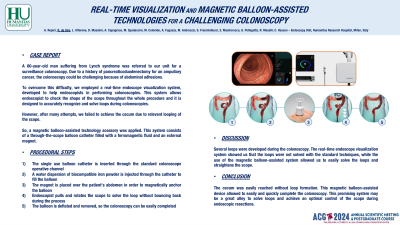Tuesday Poster Session
Category: Endoscopy Video Forum
P3879 - Real-Time Visualization and Magnetic Balloon-Assisted Technologies for a Challenging Colonoscopy
Tuesday, October 29, 2024
10:30 AM - 4:00 PM ET
Location: Exhibit Hall E


Roberto de Sire, MD
Humanitas Research Hospital
Rozzano, Lombardia, Italy
Presenting Author(s)
Repici Alessandro, MD1, Roberto de Sire, MD2, Ludovico Alfarone, MD1, Davide Massimi, MD1, Antonio Capogreco, MD1, Marco Spadaccini, MD, PhD3, Matteo Colombo, MD1, Alessandro Fugazza, MD1, Marta Andreozzi, MD1, Gianluca Franchellucci, MD1, Elisabetta Mastrorocco, MD1, Gaia Pellegatta, MD1, Roberta Maselli, MD1, Cesare Hassan, MD1
1Humanitas Research Hospital, Milan, Lombardia, Italy; 2Humanitas Research Hospital, Rozzano, Lombardia, Italy; 3Humanitas Research Hospital, Rozzano, Emilia-Romagna, Italy
Introduction: A 60-year-old man suffering from Lynch syndrome was referred to our unit for a surveillance colonoscopy. However, due to a history of pancreaticoduodenectomy for an ampullary cancer, the colonoscopy could be challenging because of abdominal adhesions
Case Description/Methods: To overcome this difficulty, we employed a real-time endoscope visualization system, developed to help endoscopists in performing colonoscopies. This real-time endoscope visualization system allows endoscopist to check the shape of the scope throughout the whole procedure and it is designed to accurately recognize and solve loops during colonoscopies. However, after many attempts, we failed to achieve the cecum due to relevant looping of the scope. So, a magnetic balloon-assisted technology acessory was applied. This system consists of a through-the-scope balloon catheter filled with a ferromagnetic fluid and an external magnet. The single use balloon catheter is inserted through the standard colonoscope operative channel. Then, a water dispersion of biocompatible iron powder is injected through the catheter to fill the balloon. After, the magnet is placed over the patient’s abdomen in order to magnetically anchor the balloon. Then, once the ballon is anchored, the endoscopist pulls and rotates the scope to solve the loop without bouncing back during the process. After, the balloon is deflated and removed, and the colonoscopy can be easily completed.
Discussion: Several loops were developed during the colonoscopy. The real-time endoscope visualization system showed us that the loops were not solved with the standard techniques, while the use of the magnetic balloon-assisted system allowed us to easily solve the loops and straightens the scope. The cecum was easily reached without loop formation. This magnetic balloon-assisted device allowed to easily and quickly complete the colonoscopy. This promising system may be a great alley to solve loops and achieve an optimal control of the scope during endoscopic resections
Disclosures:
Repici Alessandro, MD1, Roberto de Sire, MD2, Ludovico Alfarone, MD1, Davide Massimi, MD1, Antonio Capogreco, MD1, Marco Spadaccini, MD, PhD3, Matteo Colombo, MD1, Alessandro Fugazza, MD1, Marta Andreozzi, MD1, Gianluca Franchellucci, MD1, Elisabetta Mastrorocco, MD1, Gaia Pellegatta, MD1, Roberta Maselli, MD1, Cesare Hassan, MD1. P3879 - Real-Time Visualization and Magnetic Balloon-Assisted Technologies for a Challenging Colonoscopy, ACG 2024 Annual Scientific Meeting Abstracts. Philadelphia, PA: American College of Gastroenterology.
1Humanitas Research Hospital, Milan, Lombardia, Italy; 2Humanitas Research Hospital, Rozzano, Lombardia, Italy; 3Humanitas Research Hospital, Rozzano, Emilia-Romagna, Italy
Introduction: A 60-year-old man suffering from Lynch syndrome was referred to our unit for a surveillance colonoscopy. However, due to a history of pancreaticoduodenectomy for an ampullary cancer, the colonoscopy could be challenging because of abdominal adhesions
Case Description/Methods: To overcome this difficulty, we employed a real-time endoscope visualization system, developed to help endoscopists in performing colonoscopies. This real-time endoscope visualization system allows endoscopist to check the shape of the scope throughout the whole procedure and it is designed to accurately recognize and solve loops during colonoscopies. However, after many attempts, we failed to achieve the cecum due to relevant looping of the scope. So, a magnetic balloon-assisted technology acessory was applied. This system consists of a through-the-scope balloon catheter filled with a ferromagnetic fluid and an external magnet. The single use balloon catheter is inserted through the standard colonoscope operative channel. Then, a water dispersion of biocompatible iron powder is injected through the catheter to fill the balloon. After, the magnet is placed over the patient’s abdomen in order to magnetically anchor the balloon. Then, once the ballon is anchored, the endoscopist pulls and rotates the scope to solve the loop without bouncing back during the process. After, the balloon is deflated and removed, and the colonoscopy can be easily completed.
Discussion: Several loops were developed during the colonoscopy. The real-time endoscope visualization system showed us that the loops were not solved with the standard techniques, while the use of the magnetic balloon-assisted system allowed us to easily solve the loops and straightens the scope. The cecum was easily reached without loop formation. This magnetic balloon-assisted device allowed to easily and quickly complete the colonoscopy. This promising system may be a great alley to solve loops and achieve an optimal control of the scope during endoscopic resections
Disclosures:
Repici Alessandro indicated no relevant financial relationships.
Roberto de Sire indicated no relevant financial relationships.
Ludovico Alfarone indicated no relevant financial relationships.
Davide Massimi indicated no relevant financial relationships.
Antonio Capogreco indicated no relevant financial relationships.
Marco Spadaccini indicated no relevant financial relationships.
Matteo Colombo indicated no relevant financial relationships.
Alessandro Fugazza indicated no relevant financial relationships.
Marta Andreozzi indicated no relevant financial relationships.
Gianluca Franchellucci indicated no relevant financial relationships.
Elisabetta Mastrorocco indicated no relevant financial relationships.
Gaia Pellegatta indicated no relevant financial relationships.
Roberta Maselli indicated no relevant financial relationships.
Cesare Hassan indicated no relevant financial relationships.
Repici Alessandro, MD1, Roberto de Sire, MD2, Ludovico Alfarone, MD1, Davide Massimi, MD1, Antonio Capogreco, MD1, Marco Spadaccini, MD, PhD3, Matteo Colombo, MD1, Alessandro Fugazza, MD1, Marta Andreozzi, MD1, Gianluca Franchellucci, MD1, Elisabetta Mastrorocco, MD1, Gaia Pellegatta, MD1, Roberta Maselli, MD1, Cesare Hassan, MD1. P3879 - Real-Time Visualization and Magnetic Balloon-Assisted Technologies for a Challenging Colonoscopy, ACG 2024 Annual Scientific Meeting Abstracts. Philadelphia, PA: American College of Gastroenterology.

